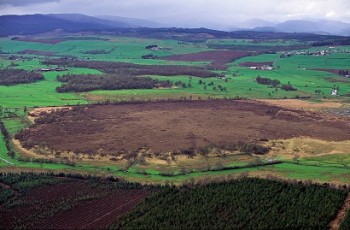Supporting guidance for Lowland Bog Management
Date published: 30 November, 2018
For recent changes to this guidance, please see the bottom of the page.
Lowland raised bog is a type of wetland. Drainage, afforestation and peat extraction all tend to dry them out and they have all had a serious impact on our lowland raised bogs.
Maintenance or restoration of suitable water levels is key to managing bogs. The Lowland Bog Management option supports the management of the water table by keeping the bog surface as intact, undisturbed and as wet as possible.
Wildlife benefits
Intact lowland raised bogs are one of Europe's most threatened habitats. They occur in the Scottish lowlands. They are recognised by gently sloping domes of peat.
Initially peat is formed from decaying fen plants, filling the depressions on which the bog sits.
Once the peat is above ground level the vegetation is dominated by bog species such as sphagnum.
These bog plants continue to form peat and the bog dome slowly builds up above the surrounding land. Over thousands of years peat can accumulate to a depth of many metres.
Because the surface of the bog is raised well above the influence of groundwater, the vegetation is dependent almost entirely on rain and snow for its source of nutrients.
Only plant species specially adapted to live in such waterlogged, nutrient-poor conditions can survive. This results in a specialised plant community. The vegetation is usually dominated by bog mosses, heathers and cotton grasses.

Raised bog at Offerance Moss, Aberfoyle – Credit: Lorne Gill – © Scottish Natural Heritage
What needs to be done?
The basic management requirements are listed in the option text. You may also choose to graze your raised bog in accordance with an approved grazing plan.
Ditch blocking
Blocking ditches using plastic piling dams or peat dams is an important way of maintaining or restoring water levels on the bog. Aim to raise the water table to, or close to the bog surface (at least within 15 centimetres of the surface). Regularly check and maintain dams to ensure the raised water levels are maintained.

Lowland bog before damming – © Scottish Natural Heritage

Lowland bog immediately after damming – © Scottish Natural Heritage
How to increase the success of this option
Grazing of bogs
Grazing is not always appropriate or practical and you should consider carefully before introducing grazing. In this boggy environment stock safety comes first.
Light grazing can help to maintain the peatland habitats in good condition and help to control the growth and spread of scrub and trees. Grazing the bog with the right numbers and type of stock means that tall heather, shrubs and rushes will be trampled and lightly browsed, allowing sphagnum moss to colonise underneath.
It is important to avoid intensive grazing as the bog surface is easily damaged by poaching. Where possible, stock should have access to adjacent ground to reduce the potential for poaching. The additional option of Management of Buffer Areas for Fens and Lowland Bogs can fund this.
Ground conditions on the site will dictate when stock are introduced and removed. Sites can be grazed during periods of drier weather in any month of the year.
Limit the amount of winter grazing because in winter the vegetation has a low food value and you will need to undertake supplementary feeding.
A short period of relatively intensive grazing (0.5 to one head of cattle per hectare or six ewes per hectare) during March, April and May can help to control birch scrub and / or purple moor-grass.
Always remove stock from the site before poaching becomes widespread and damages the surface of the bog.
Short periods (two to three weeks) of heavy grazing can be used to check scrub regrowth. Do this in dry periods to minimise damage to the ground surface.
Some traditional breeds of stock are hardier and are well suited to grazing on bog habitats. They are less selective grazers and will control scrub and heather growth more effectively.
The traditional breeds that are considered to be most appropriate for grazing lowland bog habitats are listed below:
- Cattle: Aberdeen Angus; Belted Galloway, Galloway, Highland, Luing, Shetland, Shorthorn
- Sheep: Hebridean, Soay, Cheviot, Blackface
Buffer areas
Where a lowland raised bog is bounded by improved grassland or arable crop, consider creating and managing a buffer around the bog using the relevant management and capital options. This will help you to manage the water table.
Scrub control
Scrub encroachment is often an issue on lowland raised bogs. Scrub can be controlled through one of the following capital items:
- Control of Scrub or Woody Vegetation – Primary treatment – Light Vegetation
- Control of Scrub or Woody Vegetation – Primary treatment – Intermediate and Heavy Vegetation
- Control of Scrub or Woody Vegetation – Removal from Site of the Cut Vegetation
- Control of Scrub – Follow-up treatment
Other relevant capital options
Further information
More detailed guidance is available from the Peatland Actions page of the Scottish Natural Heritage website. This includes guidance on plastic piling, reinforced and peat dams, scrub control, grazing on peatlands and so on.
Further information is also available:
Recent changes
| Section | Change |
|---|---|
| Further Information | Links to Peatland Action and Lowland raised bogs updated |
| Further information | Fen Management Handbook updated |
